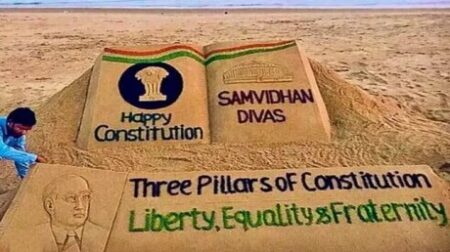“It is easy to kill individuals, but you cannot kill the ideas.”
– Bhagat Singh
Prime Minister Narendra Modi, on August 28th, virtually inaugurated the renovated Jallianwala Bagh complex. The sight, which earlier was a memoir of the sacrifices of martyrs, is now a celebration of fancy murals, glass covers, and light and sound show.
The justification lies on the premise that the earlier structure was filthy and unpresentable. The remnants of the historical system remained, such as the bullet marks on the walls and a well into which more than 100 people fell to death in an attempt to escape the massacre.
These remains are decorated and plastered post-renovation, and the chilling sight is redesigned to provide for a relaxed tourist crowd.
The place, which was once a homage to the martyrs of the Indian National Movement, is now an adventure park for tourists to pay a visit.
Arguably, the renovation has provided an opportunity to revisit and experience the story of horror through a light and sound show to celebrate the heroism of our freedom fighters.
What happened at Jallianwala Bagh?
On April 13th, 1919, thousands of people were gathered at the sight of the Jallianwala Bagh temple to peacefully protest for the arrest of nationalist leaders Saifuddin Kitchlu and Satya Pal.
In response to this, General Reginald Edward Harry Dyer ordered his troops to block the only exit of the temple and open fire on the crowd, thus killing thousands of peaceful protestors.
The explanation provided to Indians post-massacre was that; the fire was instrumented to send a message throughout the nation that any disobedience from the rule would be silenced in the same manner.
With the release of a biographical movie on to the public, the world again remembers the nerve-wrenching incident and the courageous will of Sardar Singh when he assassinated General Michael O’Dwyer, the man behind the scene who was the one who gave orders for the massacre.

What has changed?
In the hour-long virtual inauguration event, a two-minute silence was observed to pay tribute to the martyrs of the massacre. The members of the families of these martyrs were present to take part in the ceremony.
The memorial has been closed for the public since February 2019 for the renovation work by the government-owned NBCC ltd.
The Ministry of Culture has installed public toilets, clean drinking water facilities, and ticket counters.
This reformation was going well so far. But, after this, the entry and exit points of the Bagh have been repositioned, and the narrow passage which was once doomed by the footmarks of people trying to escape the Bagh is now filled with fancy murals.
The monument now surrounds lush green patches and a lotus pond. The ‘Martyrs Well’ or the ‘Shahidi Khu’ in which hundreds fell to escape the bullet fires is now controversially enclosed in a glass cabin as it restricts the view.
A 28-minute light and sound show is to be shown free of cost every evening to re-enact the events of April 13th, 1919.
A Salvation Ground has been built to sit and honour the martyrs. Four new galleries have been created to mark the incidents in and around Punjab during this phase, including the Gadar movement and the history of the freedom movement.
The sculpture of Guru Nanak Dev, Maharaja Ranjit Singh, and Banda Singh Bahadur instil a sense of pride and honour in the campus.

What’s with the celebration?
To revisit history in order to glorify and acknowledge a country’s past is justifiable. However, the will to twist, turn, and celebrate a sight and monument of horror is beyond comprehension.
History is consistently used as a tool for the enlightenment of the youth and a way to learn from the past as history repeats itself, but a solemn sight of hope and despair should be maintained as people remember it.
The glorification of gloomy past will not acknowledge the martyrs, rather confuse the coming generation about the events of the time.













